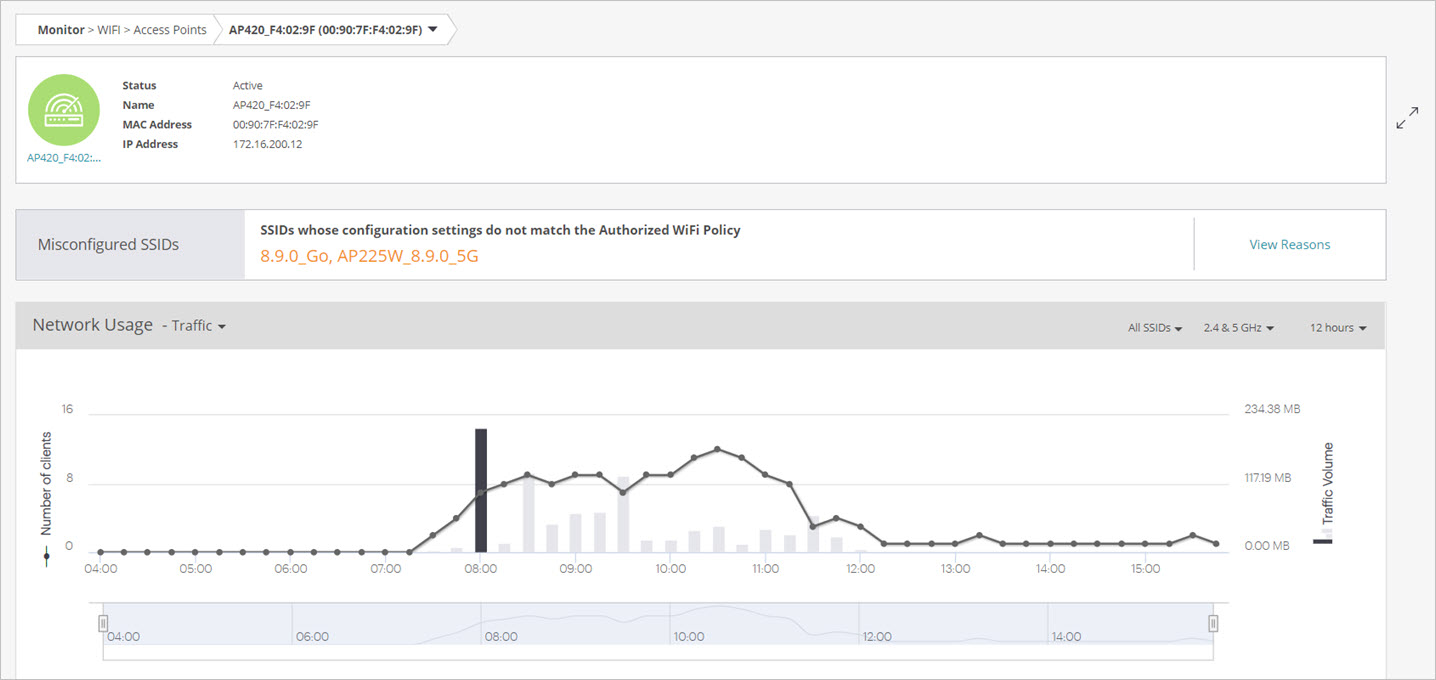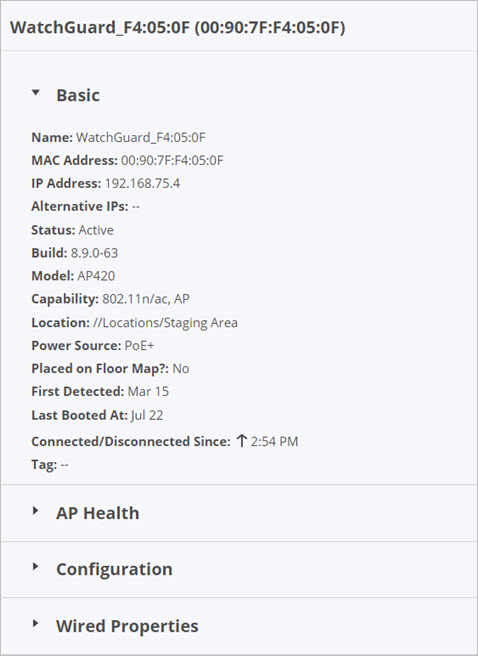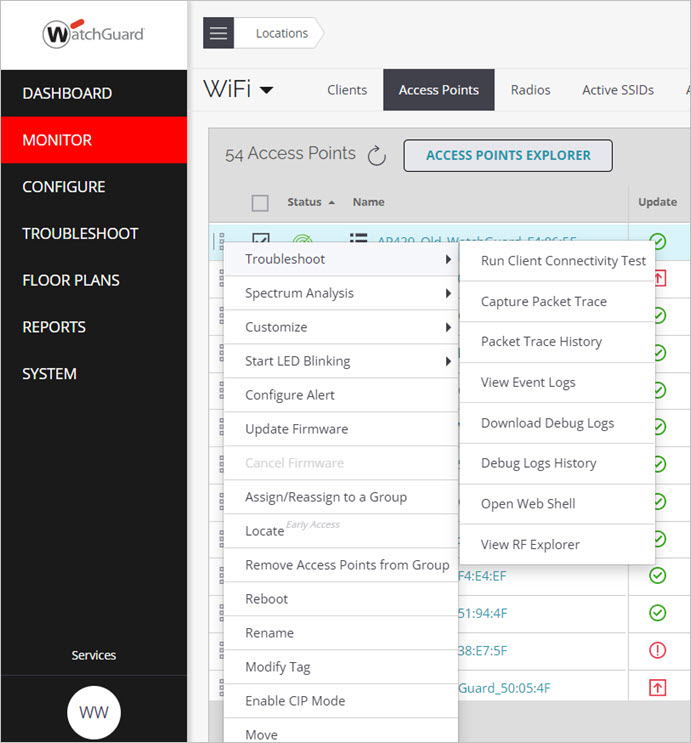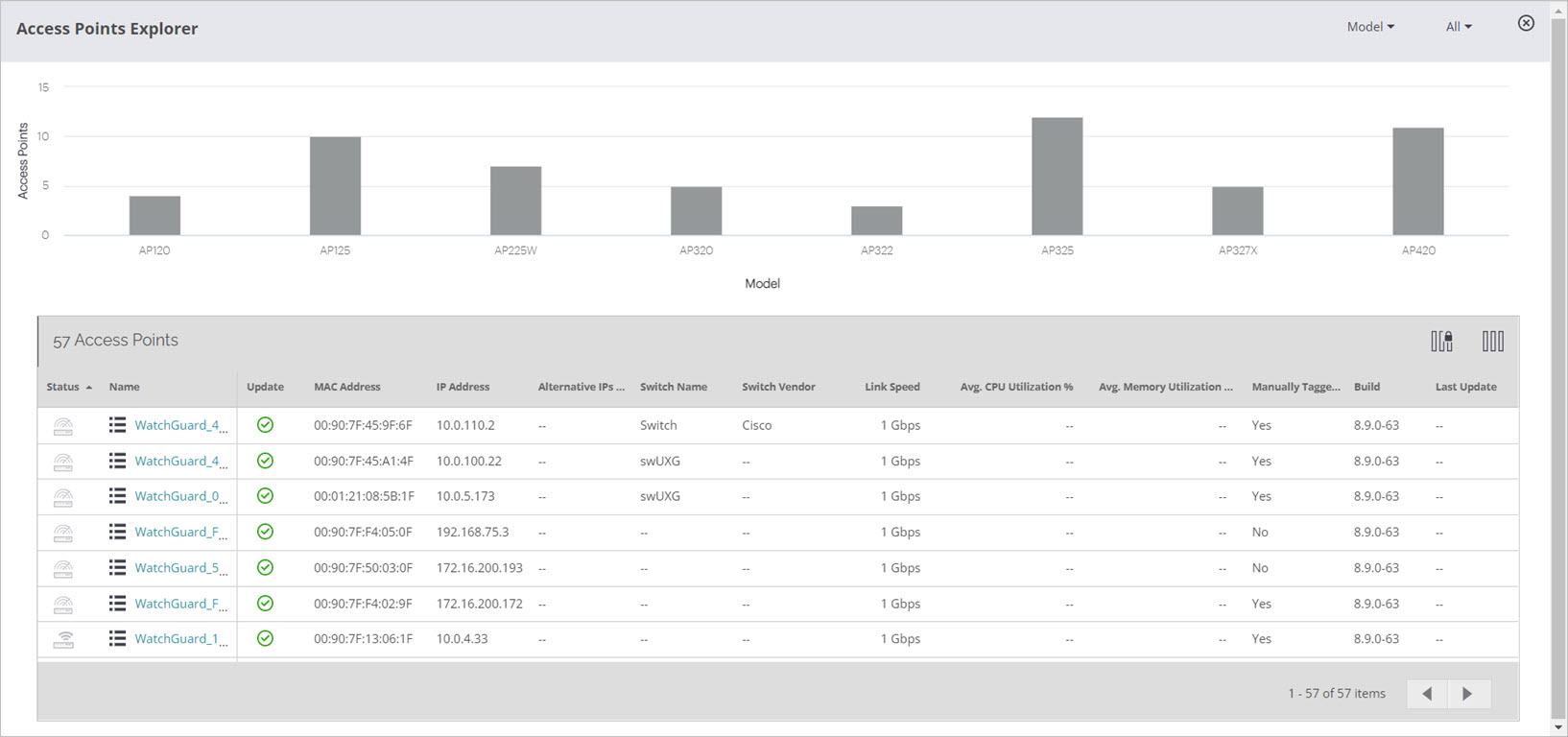Monitor Access Points
Applies To: Wi-Fi Cloud-managed Access Points (AP120, AP125, AP225W, AP320, AP322, AP325, AP327X, AP420)
To manage firmware update settings, download a device inventory, view ongoing activities, freeze columns, add or remove columns, filter the display, and switch to full screen mode, use the icons at the top-right of the page. For more information, see Table Actions for Monitor Pages.

The AP properties include this information:
| Property | Description |
|---|---|
| Status | Indicates if the AP is active (green) or inactive (red). |
| Name | Specifies the name of an AP. |
| Update | Firmware update status. |
| MAC Address | Unique 48-bit address of the AP and 802.11 PHY modes used by the AP. |
| IP Address | IP address of the AP. |
| Alternative IPs | Displays any alternative addresses for the AP such as IPv6 addresses. |
| Switch Name | The name of the switch to which the AP is connected. LLDP must be enabled on your switch to view switch information. |
| Switch Vendor | The manufacturer of the switch to which the AP is connected. LLDP must be enabled on your switch to view switch information. |
| Link Speed | The link speed for the connection between the AP and the switch. |
| Avg. CPU Utilization % | The CPU usage of the AP. |
| Avg. Memory Utilization % | The memory usage of the AP. |
| Build | The build number of the AP firmware. |
| Last Update | Date and time of the last successful firmware update |
| Scheduled Update Window | Date and time of next scheduled firmware update window. |
| Connected/Disconnected Since | Date and time since the AP was last connected or disconnected. |
| Last Booted At | Date and time since the AP was rebooted. |
| No of Associations | Number of clients associated to the selected AP. |
| Power Source | Power source for the AP. |
| Capability | A list of AP capabilities. |
| Model |
Model of the selected AP. |
| Group | The group the AP belongs to. |
| SSID | SSID broadcast by the AP. |
| Location | Location of the AP. |
| Mesh Mode | Mesh mode of the AP. |
| BLE Status | The BLE (Bluetooth Low Energy) status of an AP. |
| Tag | Additional information about the AP. |
Access Point Details
Click on an AP on the Access Points page, to see the following information:

| AP Widgets | Description |
|---|---|
| AP Issues | Any issues with the AP are listed. Click the View Reasons link to see the cause of the issue. |
| Network Usage |
|
| Baseline |
|
| Clients by Average Data Rate | A bar graph of clients and their data rate (in Mbps) for the selected AP. |
| Top Applications By Traffic | A bar graph of the top five applications with the highest data usage for the selected AP. |
| Spectrum Occupancy | A chart that shows the number of radios and clients that were active in a frequency band. A Channel Map is also available that shows the number of clients and APs visible to the managed AP on a specific channel. |
| Channel Utilization | A chart that shows the AP channel band utilization for the selected duration. |
| Currently Associated Clients | A list of clients that are currently associated to the AP. |
| AP Health | Shows the average CPU and memory utilization of an AP. |
| Radios Seeing this AP | Displays the list of managed device radios visible to the selected AP. |
| Visible VLANs | A list of VLANs visible to the AP. |
| Visible Access Points | A list of other APs visible to this AP. |
| Visible Clients | A list of clients visible to the AP. |
Access Point Properties
Click the AP name to see the detailed AP properties.
This information includes basic information such as AP name, MAC address, IP address, location, firmware build, and power source details.
You can also view:
- AP Health — Shows CPU and memory utilization.
- Configuration — Indicates the AP location, operating mode, SSID, and channel information.
- Wired Properties — Indicates the wired side properties of an AP. This includes the switch details, the link speed, and the VLANs detected by the AP. The IP address network properties of the AP include the DHCP and DNS servers the AP uses, and the DHCP lease time.
LLDP must be enabled on your switch to view switch information.

AP Issues
Any detected issues with the AP are listed. Click the View Reasons link to see the cause of the issue.
In this example, the SSID broadcast by the AP is misconfigured and does not match the Authorized WiFi Policy.

Access Point Actions
To perform actions on an AP, right-click the AP name, and select an action:

- Troubleshoot
- Run Client Connectivity Test — Run a client connectivity test on the AP. For more information, see Client Connectivity Test.
- Capture Packet Trace — Perform a packet trace on an AP. For more information, see Capture Packet Trace.
- Packet Trace History — View the packet trace history for a selected AP.
- View Event Logs — View the AP event logs. For more information, see Access Point Event Logs.
- Download Debug Logs — Download the AP debug logs. For more information, see Debug Logs.
- Debug Logs History — View the debug logs history for the AP.
- Open Web Shell — Opens an SSH connection to the AP to perform commands with the command line interface (CLI). You can only use SSH access for an AP in conjunction with WatchGuard Technical Support for troubleshooting purposes.
- View RF Explorer — View the details of what an AP sees in its RF neighborhood. For more information, see RF Explorer.
- Spectrum Analysis — Start spectrum analysis to visually display RF frequencies in the APs area (AP225W, AP325, and AP420 only). For more information, see Spectrum Analysis.
- Customize
- Transmit Power or channel — Manage the transmission power of the AP.
- BLE — Manage the BLE (Bluetooth Low Energy) settings for the AP.
- VLANS — Manage additional VLAN monitoring on the selected AP. You can create a static IP address for the AP or use DHCP on the specified VLAN. For more information, see How to set a static IP address for an AP in WatchGuard Wi-Fi Cloud.
- IPSec Credentials — Configure custom IPSec credentials for a remote AP. For more information, see Remote Access Point.
- Start LED Blinking — Flash the LEDs on the AP for identification. This feature is only supported on 802.11ac Wave 2 APs. (Not supported on AP120, AP320, and AP322). This is useful if you have disabled LEDs on the AP for security reasons. You can select a duration of 5, 15, or 30 minutes. For more information on how to disable AP LEDs, see Configure Device Settings.
- Configure Alert — Configure alerts for the AP.
- Update Firmware — Update the firmware on an AP. For more information, see Update AP Firmware in Wi-Fi Cloud.
- Assign/Reassign to a Group — Add or remove the AP from a group. For more information, see AP Groups.
- Locate — View the location of the AP on the floor map. If there is no floor map available, the locate function shows the APs approximate distance from the closest sensing AP. For more information, see Locate APs and Clients.
- Remove Access Points from Group — Removes the selected AP from a group.
- Reboot — Reboots the AP.
- Rename — Renames the AP.
- Modify Tag — Change the tag for the AP.
- Enable CIP Mode (AP420 only) — Configure an AP420 in Cloud Integration Point (CIP) mode. For more information, see Wi-Fi Cloud Integration with Third-Party Controllers using CIP.
When you configure an AP420 in CIP mode, the AP radios do not perform access point or WIPS sensor functions. An AP in CIP mode is dedicated to processing CIP services.
- Move — Change location of the AP.
- Delete — Deletes the AP from the list of available APs.
Access Points Explorer
Access Points Explorer provides an overview of all APs at a location and enables you to view a graphical AP distribution based on selected AP properties.
To view the Access Points Explorer:
- Select Monitor > WiFi > Access Points.
- Click Access Points Explorer.
You can also view the Access Points Explorer in Monitor > WIPS > Managed Device Explorer.

You can filter the devices based on the device status (All, Active, or Inactive).
Use the attribute drop-down menu to view graphical AP distribution based on:
- Model
- Switch Name
- Power Source
- Group
- BLE Status
- Capability
- Build
- Update
- Link Speed
- Switch Vendor
- Average CPU Utilization
- Average Memory Utilization
- Tag
- Failsafe Mode